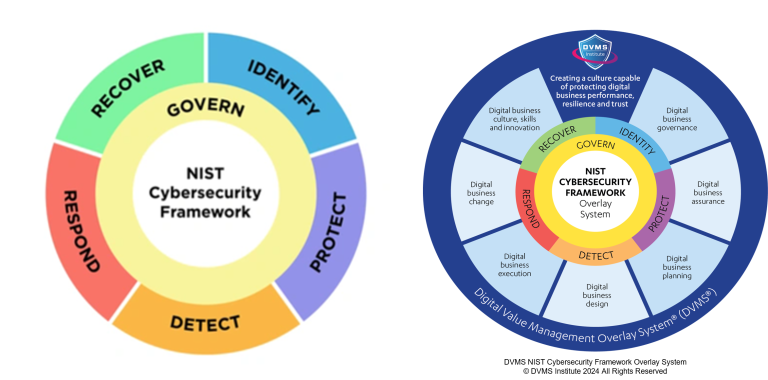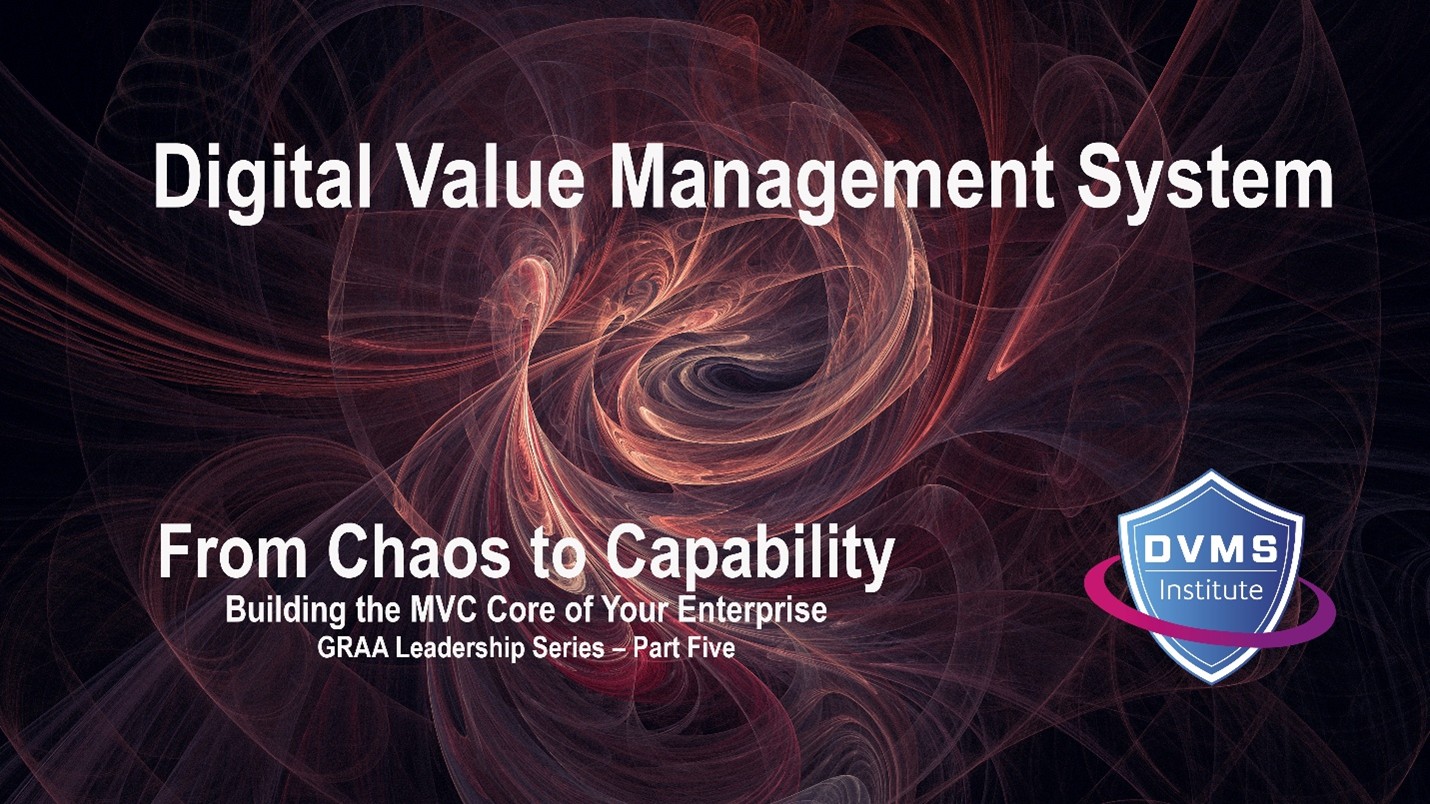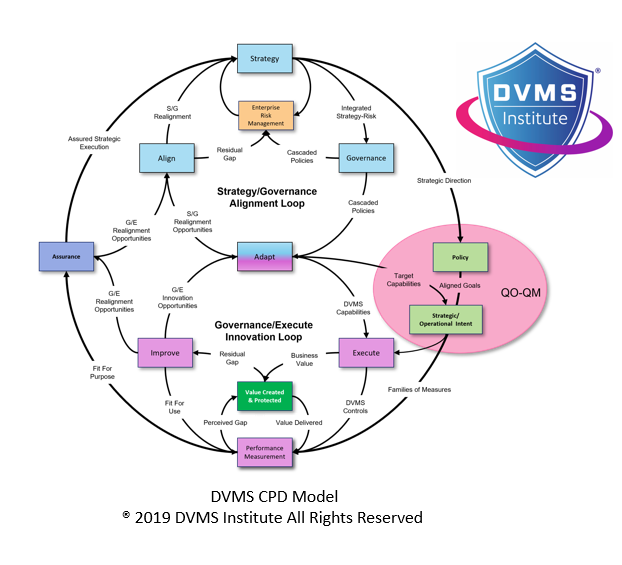Reducing Cybersecurity Operations Costs Using the NIST-CSF and a Digital Value Management System
Rick Lemieux – Co-Founder and Chief Product Officer of the DVMS Institute
The escalating costs of cybersecurity operations have become a significant burden for organizations across sectors. However, the combined implementation of the NIST Cybersecurity Framework (CSF) 2.0 and the Digital Value Management System® (DVMS) offers a structured, cost-reducing approach. Together, they help organizations enhance their cyber resilience and control and optimize cybersecurity investments by embedding cybersecurity risk management into everyday business operations. Fundamentally, both frameworks shift cybersecurity from a technical concern to an enterprise-wide strategic function, enabling smarter spending, reduced duplication of efforts, and better risk-informed decisions.
At its core, the NIST CSF 2.0 provides a taxonomy of high-level cybersecurity outcomes arranged across six key Functions: Govern, Identify, Protect, Detect, Respond, and Recover. This outcomes-based structure enables organizations to focus on what they need to achieve rather than prescribing rigid technical controls. As a result, organizations avoid investing heavily in one-size-fits-all technical solutions that may not align with their risk profiles or business priorities. Instead, they can assess their current and target cybersecurity posture through Organizational Profiles and identify gaps precisely, thus focusing their cybersecurity spending where it matters most. This targeted risk management and prioritization approach reduces unnecessary expenditures on technologies or practices that provide little value or risk reduction.
The CSF also introduces Tiers to characterize cybersecurity risk governance practices, from ad hoc (Tier 1) to adaptive and continuous improvement (Tier 4). Organizations can use these Tiers to assess the maturity of their cybersecurity efforts and make incremental improvements aligned with cost-benefit analysis. Rather than striving for the highest maturity level everywhere, organizations can calibrate investments according to the criticality of business processes and the threat landscape. This avoids overengineering security where it is unnecessary and helps allocate budgets more efficiently.
Building on this, the Digital Value Management System (DVMS) expands the NIST CSF’s guidance by offering a scalable, systems-based overlay to manage digital business risk holistically. The DVMS approach repositions cybersecurity from being a separate, siloed technical function to an integrated component of overall enterprise governance. This reframing ensures that cybersecurity investments are aligned with broader organizational strategies, effectively tying cybersecurity operations to value creation and protection. By simultaneously focusing on creating, protecting, and delivering digital business value, the DVMS eliminates the waste of resources caused by treating security and business objectives separately. This common pitfall leads to duplicative or misaligned cybersecurity initiatives.
The DVMS further reduces costs by enabling organizations to leverage existing capabilities. Instead of building new cybersecurity structures from scratch, the DVMS overlays what organizations already do. It helps map existing frameworks, practices, and processes into its minimum viable capabilities—Govern, Assure, Plan, Design, Change, Execute, and Innovate. This flexible, adaptable structure avoids expensive “rip and replace” transformation projects. Organizations can stabilize their current environment first and gradually improve their cybersecurity resilience through small, iterative steps using the DVMS FastTrack™ methodology. This incremental, phased approach reduces operational disruptions and capital expenditures, promoting long-term financial sustainability.
Another meaningful way the DVMS helps control cybersecurity costs is by embedding systems thinking and cultural transformation into cybersecurity practices. Systems thinking promotes a deeper understanding of organizational interdependencies and helps uncover hidden risks and inefficiencies. By addressing root causes rather than symptoms, such as addressing cultural issues or communication breakdowns, organizations prevent expensive cybersecurity incidents before they occur. Moreover, creating a risk-aware culture throughout the enterprise reduces the need for costly standalone security training or isolated security functions. Security becomes part of everyday operations, decision-making, and innovation efforts, significantly improving efficiency and lowering operational overhead over time.
The NIST CSF and DVMS strongly emphasize proactive risk management, rather than reactive, crisis-driven cybersecurity. This proactive orientation, supported by tools like business impact analyses, governance policies, and risk prioritization models, helps organizations avoid the much greater costs associated with data breaches, regulatory fines, and reputational damage. According to studies cited in the DVMS Institute’s Practitioner’s Guide, a well-managed cybersecurity program can significantly lower the average cost of data breaches. As championed by the Protect and Detect functions of the NIST CSF, prevention and early detection activities cost far less than incident response and recovery efforts following a significant breach.
Furthermore, the DVMS encourages using QO-QM (Question Outcome–Question Metric) methods to link cybersecurity performance directly to business outcomes. This connection ensures that cybersecurity spending is continuously evaluated for effectiveness and relevance. Instead of measuring success solely by technical metrics (e.g., number of patches applied), organizations measure it by how well cybersecurity supports strategic goals such as market expansion, operational uptime, and customer trust. This outcome-driven measurement fosters continuous improvement cycles that prioritize only those cybersecurity investments that deliver the most significant business value, further optimizing operational costs.
The DVMS also helps organizations recognize that not all cybersecurity events are equally critical. The Institute’s 3D Knowledge Model promotes a nuanced understanding of digital assets, dependencies, and threat exposures. This nuanced risk segmentation helps organizations right-size their cybersecurity defenses to match asset value and risk tolerance. Rather than adopting expensive, blanket security measures across the board, organizations apply stronger protections to their crown jewels and adopt lighter-touch controls elsewhere, thereby balancing cost and protection.
Finally, organizations build agility into their cybersecurity operations by adopting the DVMS with the NIST CSF. The ability to adapt quickly to new threats, regulatory changes, and business innovations without undertaking massive, costly overhauls is a critical factor in sustaining lower cybersecurity operational costs. Agile, resilient organizations can reallocate cybersecurity resources as needed, without expensive firefighting, emergency hiring, or buying redundant technologies after incidents.
The NIST Cybersecurity Framework and the Digital Value Management System offer a transformational way to manage cybersecurity economically. Promoting a risk-based, business-aligned, outcomes-driven, and systems-oriented approach, they help organizations eliminate waste, prevent costly incidents, optimize resource allocation, and align cybersecurity investments tightly with value creation. Organizations that adopt this integrated model can achieve greater cyber resilience and a substantial reduction in the total cost of cybersecurity operations, turning cybersecurity from a financial burden into a strategic enabler for long-term business success.
About the Author

Rick Lemieux
Co-Founder and Chief Product Officer of the DVMS Institute
Rick has 40+ years of passion and experience creating solutions to give organizations a competitive edge in their service markets. In 2015, Rick was identified as one of the top five IT Entrepreneurs in the State of Rhode Island by the TECH 10 awards for developing innovative training and mentoring solutions for boards, senior executives, and operational stakeholders.
The DVMS Institute’s NIST Cybersecurity Framework Digital Value Management System® certified training programs teach enterprises of any size, scale, or complexity the skills to build a Holistic, Adaptive, and Culture-Powered Enterprise Cyber Resilience System and Team capable of proactively identifying and mitigating the systemic risks that impact digital business operations.
Enterprises can become resilient by embedding systemic risk management into strategic decision-making and aligning it with adaptive Governance, Resilience, Assurance, and Culture.
This unique and innovative approach to Cyber Resilience also enables enterprises to be compliant with any regulatory (SEC , UK, DORA, NIS2, SAMA, SOCI, IMO, MCU) or maturity model program (HITRUST, CMMC, C2M2, SCF).
® DVMS Institute 2025 All Rights Reserved




